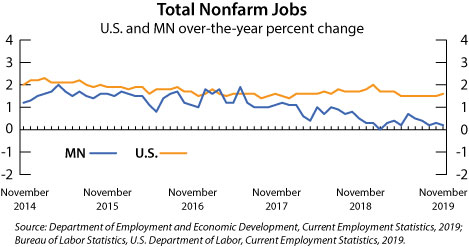by Nick Dobbins
December 2019
Monthly analysis is based on unadjusted employment data.
The Minneapolis-St. Paul area lost 7,970 jobs (0.4 percent) in November, which was slightly ahead of the state’s 0.5 percent decrease. As was the case statewide, the metro area declines were largely driven by losses in Mining, Logging, and Construction, which was off by 7,868 (8.5 percent). Component Specialty Trade Contractors was responsible for 5,004 of that decline (down 8.4 percent). Leisure and Hospitality, another highly seasonal supersector, lost 2,539 jobs (1.3 percent) with a loss of 2,299 (6.5 percent) in Arts, Entertainment, and Recreation. The largest increase, in both real and proportional terms, came in Trade, Transportation, and Utilities, which added 5,597 jobs or 1.5 percent. Each of the three major component sectors added jobs. Over the year the Twin Cities metro lost 5,729 jobs (0.3 percent). It was the only metropolitan statistical area (MSA) in the state to lose jobs on an annual basis, which it has done for four consecutive months. November’s annual decline was broad-based, but largely driven by the loss of 10,189 jobs (3 percent) in Educational and Health Services. Health Care and Social Assistance was off by 9,495 (3.3 percent) with Nursing and Residential Care Facilities down 3,055 (5.2 percent) and Ambulatory Health Care Services down 4,322 (4.6 percent). Leisure and Hospitality was up by 5,748 jobs (3.1 percent), with all of that growth coming from the Accommodation and Food Services component sector (up by 6,638 or 4.4 percent).
Employment in the Duluth-Superior MSA was down by 804 (0.6 percent) in November. Mining, Logging, and Construction lost 1,202 jobs (11.2 percent), and Leisure and Hospitality lost 547 (3.8 percent). Trade, Transportation, and Utilities added 651 jobs (2.6 percent), the largest real and proportional gains of any supersector in the area, as Retail employers added 603 jobs (4 percent) in advance of the holiday season. Annually employment in the Duluth MSA was mostly flat, as the area added 12 jobs (0.0 percent). With every other MSA in the state adding jobs faster on the year, the two lowest growth rates belonged to Minnesota’s two largest MSAs. Mining, Logging, and Construction lost 434 jobs (4.4 percent) in Duluth while Trade, Transportation, and Utilities added 494 (2 percent), mirroring the monthly changes.
Employers in Rochester lost 972 jobs (0.8 percent) in November. It was the largest decline of any MSA in the state. Manufacturing employment was off by 445 (3.8 percent), driving the losses, but seven of the area’s 10 published supersectors lost jobs on the month. Other Services employment was perfectly flat, while Trade, Transportation, and Utilities and Government each added 154 jobs (0.8 and 1.2 percent, respectively). Over the year the Rochester MSA added 1,253 jobs (1 percent). Trade, Transportation, and Utilities added 862 jobs (4.8 percent) as Retail employment was up by 778 (6.3 percent). Manufacturing was up by 390 (3.6 percent). Educational and Health Services lost 506 jobs (1.0 percent).
The St. Cloud MSA lost 609 jobs (0.5 percent) in November. Mining, Logging, and Construction lost 477 jobs (5.8 percent), and Leisure and Hospitality lost 298 (3.6 percent). Trade, Transportation, and Utilities added 244 jobs (1.1 percent). On the year the MSA added 1,016 jobs (0.9 percent). Mining, Logging, and Construction added 591 jobs (8.3 percent), giving it the largest proportional over-the-year job growth while at the same time it had the largest proportional over-the-month job loss. Financial Activities employment was up by 146 jobs or 2.8 percent.
The Mankato-North Mankato MSA added 189 jobs (0.3 percent). Service providers added 346 jobs (0.7 percent) while goods producers lost 157 (1.5). It was the only MSA primarily in Minnesota to add jobs in November. Both MSAs shared with North Dakota also added jobs. On the year the Mankato area added 1,518 jobs (2.5 percent). It was the largest over-the-year employment increase in the state. Service providers added 1,599 (3.3 percent) while goods producers lost 81 (0.8 percent).
The Fargo-Moorhead MSA added 461 jobs (0.3 percent) in November. Trade, Transportation, and Utilities led the way, adding 485 jobs (1.7 percent), with most of that gain coming in Retail Trade (up 461 or 3.2 percent). Over the year the MSA added 2,364 jobs (1.7 percent). Professional and Business Services added 1,295 (8.2 percent), and Leisure and Hospitality added 943 (6.9 percent), while Trade, Transportation, and Utilities employment was down by 825 (2.7 percent) with most of that loss coming in Retail Trade (down 1,066 or 6.7 percent).
Employment in the Grand Forks-East Grand Forks MSA was largely flat in November as the area added 35 jobs (0.1 percent), making it one of only three MSAs in the state to add jobs on the month. Government employers added 191 jobs (1.4 percent), and Trade, Transportation, and Utilities was up by 129 (1.2 percent), while Mining, Logging, and Construction was down by 282 (9.6 percent). On the year employers added 169 jobs (0.3 percent). Government employers added 256 jobs (1.9 percent). Trade, Transportation, and Utilities employment was off by 268 (2.4 percent), and Mining, Logging, and Construction was down 146 (5.1 percent).
